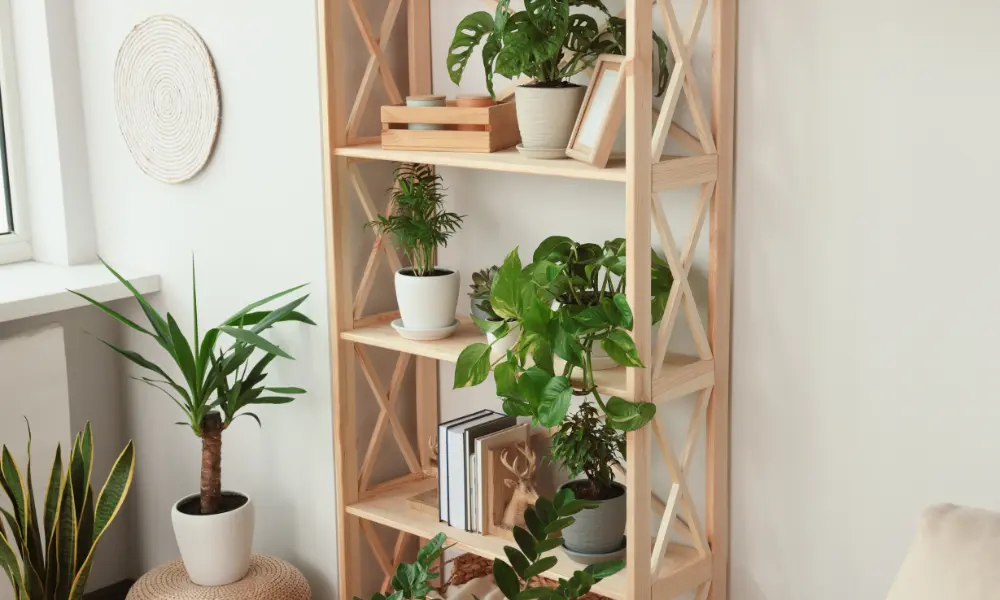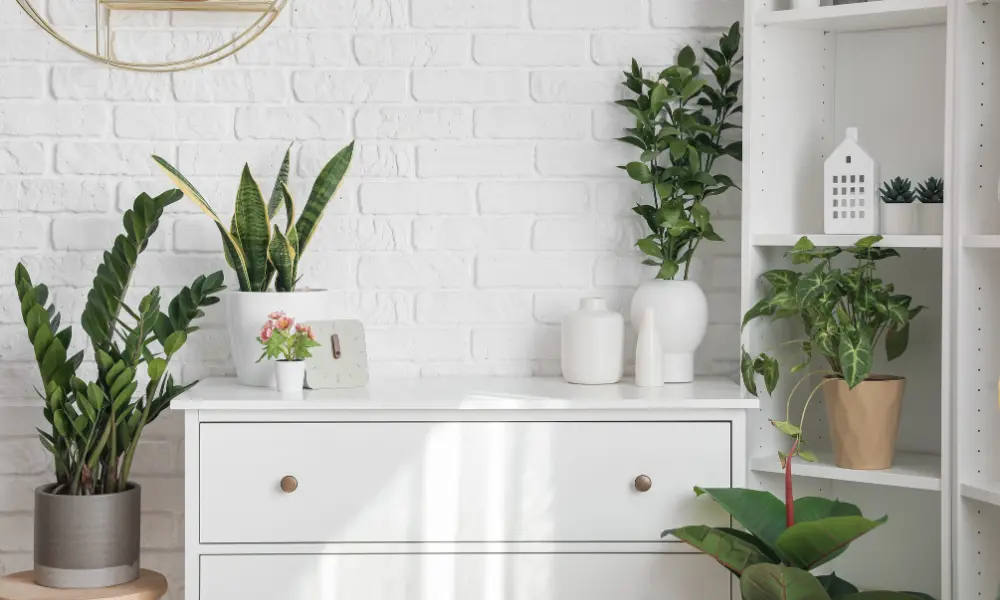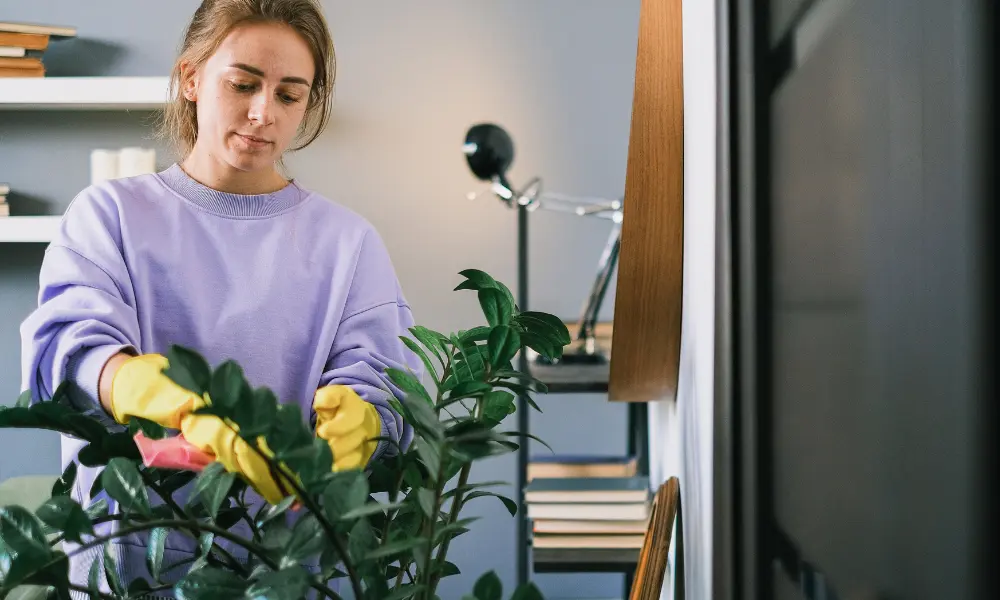
Plants that purify the air in compact spaces are essential allies for those living in small spaces where air circulation is limited and air quality quickly deteriorates. More than just decoration, these unobtrusive species act as natural filters, promoting well-being without compromising visual lightness.
In this article, you’ll discover which plants are ideal for refreshing your space, creating a healthier environment, and transforming your home with balance and functionality.
Why air purification is essential in small spaces
Living in compact spaces offers practicality, but also challenges. One of the most neglected is air quality. In apartments, studios, or small rooms, ventilation isn’t always ideal, which favors the accumulation of dust, pollutants, and even toxic compounds released by furniture, paints, and cleaning products.
Without proper air renewal, these elements harm health, increasing feelings of fatigue, headaches, and respiratory irritations. This is where air-purifying plants for compact spaces become valuable allies.
They don’t just decorate, but act as natural filters, absorbing pollutants like formaldehyde, benzene, and toluene, while balancing air humidity and improving the sensation of freshness.
Impact of poor air quality in enclosed environments
Indoor air can be up to five times more polluted than outdoor air, according to the World Health Organization (WHO). In small spaces, the concentration of pollutants is even higher, aggravated by poor ventilation and the use of chemical products.
Among the main impacts are:
- Increased allergies and respiratory problems.
- Feeling of stuffiness and discomfort.
- Decreased productivity and well-being.
These effects are more noticeable in compact apartments, where every square foot counts and there’s no room for excess ventilation.
How plants act in filtering pollutants
Purifying plants work in a simple and efficient way:
- Absorb pollutants from the air through leaves and roots.
- Transform CO₂ into oxygen, renewing the air in the environment.
- Help maintain humidity at healthier levels.
Species like snake plant, pothos, and spider plant are known for their ability to filter toxins and improve air quality, even in small spaces.
Additionally, studies by NASA and leading universities have already proven the effectiveness of various plants in this natural purification process.
Emotional and physical benefits of biophilia in compact spaces
Biophilia, a concept that defines our innate connection with nature, has a direct impact on mental and emotional health. Having plants at home, besides improving air quality, promotes:
- Stress reduction.
- Improved mood and concentration.
- Feeling of comfort and tranquility.
In compact spaces, where visual excess is tiring, greenery brings balance and sensory relief, creating a healthier environment in every sense.
Beyond improving air quality, including plants in compact spaces is a choice that also aligns with values of sustainability and well-being. If you want to understand how greenery can transform decoration consciously, check out our article on Sustainable Decoration: Minimalism and the Importance of Plants.
Compact plants that really purify the air

You don’t need to have a forest inside your home to improve air quality. Some compact and discreet plants are true allies in purifying the space, acting as natural filters that absorb pollutants and bring more freshness to the space.
Below, see which small but powerful species are ideal for those seeking a healthier and aesthetically lighter home.
Snake Plant (Sansevieria trifasciata)
Classic and unbeatable, the snake plant is known for its resilience and air-purifying capacity. Its vertical leaves filter toxins like formaldehyde and benzene, common in cleaning products and furniture.
Ideal for:
Living room corners, hallways, and areas with little natural light.
Why it’s minimalist:
Its vertical and sculptural shape complements spaces with straight lines and compact spaces.
Pothos (Epipremnum aureum)
Pothos is a versatile hanging plant, capable of absorbing pollutants and regulating humidity. It grows well in hanging pots or on shelves, without requiring large spaces.
Ideal for:
High shelves, hanging supports, and even floor pots in small studios.
Why it’s minimalist:
Its vibrant green brings life without visually polluting the environment, especially when controlled with light pruning.
Spider Plant (Chlorophytum comosum)
Also known as airplane plant, the spider plant is one of the champions in removing carbon monoxide and toxins. Compact, it’s perfect for indoor spaces.
Ideal for:
Hanging pots in kitchens, bathrooms, or small balconies.
Why it’s minimalist:
Its light and arched shape creates visual movement without excess.
Peace Lily (Spathiphyllum wallisii)
Beyond its delicate beauty, the peace lily is effective in filtering volatile organic compounds. Its white flowers bring a touch of elegance to the space.
Ideal for:
Side tables, consoles, and compact offices.
Why it’s minimalist:
Its soft palette and contained size enhance the lightness of the environment.
Peperomia (Peperomia obtusifolia)
With thick leaves and a soft shine, peperomia is a discreet plant that helps purify the air in small environments.
Ideal for:
Niches, shelves, coffee or side tables.
Why it’s minimalist:
Its variety of textures and small sizes allows for delicate and organized compositions.
Mini Boston Fern (Nephrolepis exaltata ‘Bostoniensis’)
Compact and dense, the mini Boston fern is efficient in removing pollutants and regulating humidity. Despite having a voluminous appearance, it can be grown in small hanging pots.
Ideal for:
Bathrooms, kitchens, and small balconies.
Why it’s minimalist:
If strategically positioned, it adds texture without visually weighing down the space.
ZZ Plant (Zamioculcas zamiifolia)
The ZZ plant is perfect for those who want low effort and high visual impact. Its dark green leaves absorb pollutants and are extremely resistant.
Ideal for:
Living room corners, hallways, offices.
Why it’s minimalist:
Its geometric structure and vertical growth complement clean environments with elegance.
How to position plants to maximize air purification
Having purifying plants is a great start, but to ensure they really improve air quality, it’s essential to know how and where to position them. In compact spaces, every detail makes a difference — and how you distribute your plants can enhance their benefits without compromising minimalist aesthetics.
Strategic distribution in apartments and studios

In small spaces, plants should be seen as balance points, not as fillers for empty spaces. The key is to:
- Position plants near pollution sources, such as new furniture, appliances, or high-traffic areas.
- Distribute species vertically and horizontally to optimize the area of action (one plant on the floor, another on high shelves, one suspended).
- Avoid accumulation in a single point: spread with intention.
💡 Practical example:
In a studio, a snake plant in the corner of the living room, a hanging pothos in the kitchen, and a suspended spider plant in the bathroom create an efficient purification network.
Using stands, shelves, and hanging pots
In compact spaces, verticalization is a powerful ally. Using stands and shelves allows you to keep the floor clear, facilitating circulation and preserving visual lightness.
- Elevated stands highlight sculptural plants like the ZZ plant.
- Floating shelves are perfect for peperomias and pileas.
- Hanging pots create visual movement and expand the plants’ action throughout the entire volume of the environment.
These elements help compose a healthy and organized environment without compromising the minimalist concept.
Importance of adequate ventilation and lighting
Although plants help purify the air, they also need good conditions to perform this function:
- Cross or sporadic ventilation improves filtering efficiency.
- Indirect and diffused light is ideal for most small purifying plants.
- Stuffy environments with little light require more resistant species (like snake plant and ZZ plant).
Keeping plants in suitable locations is as important as choosing them well. After all, a healthy plant is much more efficient in purifying the air.
Maintenance tips for purifying plants in compact spaces
Keeping your purifying plants healthy is essential for them to fulfill their function of improving air quality. In small spaces, maintenance should be even more careful, respecting the balance between practicality, aesthetics, and environmental health.
Here are the main guidelines to ensure your compact plants are always vibrant and efficient.
Controlled watering to avoid excessive moisture
Small environments tend to retain more moisture, which can cause mold and compromise both plants and the environment. Therefore:
- Avoid soaking the soil. Prefer watering in smaller quantities and with frequency adjusted to the species.
- Check the substrate by touch: if it’s still moist, postpone the next watering.
- Pay special attention to plants like peace lilies and ferns, which like moisture but not excess standing water.
💡 Extra tip: Use pots with good drainage and saucers with pebbles to prevent water accumulation directly at the bottom.
Cleaning leaves to enhance filtering

Dust accumulation on leaves reduces plants’ purification capacity. Keeping leaves clean is fundamental to ensure the efficiency of the process.
- Use a damp cloth or soft sponge to remove dust from large leaves (e.g., ZZ plant, snake plant).
- For plants with small or delicate leaves, spray water and clean carefully.
- This practice also prevents pest infestations.
Keeping leaf surfaces free of dirt is one of the simplest and most effective ways to optimize plants’ purifying function.
How to prevent plants from visually overwhelming the environment
Maintenance is also aesthetic. In compact spaces, disorderly plants or uncontrolled growth can compromise visual lightness.
- Do light and regular pruning to maintain shape and control volume.
- Remove dry or yellowed leaves to preserve clean aesthetics.
- Avoid accumulating new pots without reviewing the space composition: maintain a reduced number and position with intention.
💡 Reminder: The minimalist philosophy also applies to plant care — less quantity, more quality.
Comparative Table — Purifying plants for small spaces
If you want practicality when choosing which plants to bring into your compact space, this comparative table will make it much easier. We’ve gathered the main compact and efficient species in purifying the air, with clear information about size, care level, and where they fit best.
| Plant | Size | Care Level | Purification Effectiveness | Ideal for… |
|---|---|---|---|---|
| Snake Plant | Medium | Very low | High | Corners, hallways, areas with little light |
| Pothos | Medium | Low | High | High shelves, hanging pots |
| Spider Plant | Small | Low | Very high | Hanging pots in kitchens and bathrooms |
| Peace Lily | Small | Moderate | High | Side tables, compact offices |
| Peperomia | Small | Low | Moderate | Niches, shelves, and bookcases |
| Mini Boston Fern | Small | Moderate | High | Bathrooms, kitchens, small balconies |
| ZZ Plant | Medium | Very low | High | Living room corners, home office, entrance |
✅ How to use this table in practice:
- Choose species according to available space.
- Take into account your time and availability for routine care.
- Think about visual impact: vertical, hanging, or compact plants help maintain a clean environment.
This selection was designed for those seeking the perfect balance between functionality, aesthetics, and practicality in reduced spaces.
Conclusion: The power of compact plants for a healthier and lighter home
Air-purifying plants for compact spaces are much more than decorative elements: they act as natural filters, bringing freshness, well-being, and quality of life to your home.
Even in small environments, it’s possible to create a cozy, healthy, and visually balanced space without sacrificing simplicity. The right choice of species, combined with strategic placement, transforms any corner into a refuge of lightness and connection with nature.
Whether through the robustness of the snake plant, the versatility of pothos, or the delicacy of the peace lily, the important thing is to integrate greenery with purpose and intention.
Remember: in minimalism, less is more — but when greenery is well positioned, it’s worth much more.
📌 Want to continue transforming your home with the power of plants? Discover how to create conscious decoration in Sustainable Decoration: Minimalism and the Importance of Plants.
